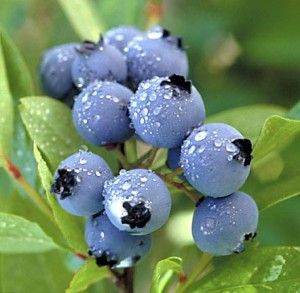Latin American blueberries found to be ‘extreme superfruits’
One of the treats of summer - fresh, antioxidant-rich blueberries - has new competition for the title of “superfruit.”
But at least the contenders are keeping the title in the family.
Researchers have found that two species of wild blueberries native to the tropical regions of Central and South America - the New World tropics, or Neotropics - contain two to four times more antioxidants than the blueberries sold in U.S. markets.
This finding is the result of an analysis of the compounds contained in neotropical blueberries grown at The New York Botanical Garden.
The study was conducted by Professor Edward Kennelly, a biologist at Lehman College in the Bronx who is an expert in medicinal plants, and Paola Pedraza, Ph.D., a botanist at The New York Botanical Garden whose specialties include South American blueberry species.
“No one had looked at this,” Dr. Pedraza said. “The results are very promising.”
 For their study, published in the peer-reviewed Journal of Agricultural and Food Chemistry, the scientists examined five species of neotropical blueberries. The two species that had the highest amounts of antioxidants were Cavendishia grandifolia and Anthopterus wardii.
For their study, published in the peer-reviewed Journal of Agricultural and Food Chemistry, the scientists examined five species of neotropical blueberries. The two species that had the highest amounts of antioxidants were Cavendishia grandifolia and Anthopterus wardii.
“We consider these two species of neotropical blueberries to be extreme superfruits with great potential to benefit human health,” Dr. Kennelly said.
Antioxidants found in fruits and vegetables have been associated with lower incidence of some chronic diseases and may help protect against heart disease, inflammatory ailments such as chronic obstructive pulmonary disease (COPD), and even cancer.
Of the five neotropical blueberry species used in the study, four came from the Nolen Greenhouses for Living Collections and the Enid A. Haupt Conservatory at The New York Botanical Garden. One came from the Atlanta Botanical Garden.
Although these blueberries are wild species that are not currently commercially available, the scientists believe that they have the potential to become a popular food item or health supplement if their high antioxidant content becomes better known.
“I think it’s just a matter of time until people start working on making them more available,” Dr. Pedraza said.
More than 600 neotropical species are related to the “highbush” blueberries common to the American market. Several of them, including the two most promising species in Drs. Kennelly and Pedraza’s study, are native to the high-elevation forests of the Andes Mountains, one of the most endangered ecosystems in the world.
The discovery that these blueberries have potential benefits for humans underscores the importance of preserving Earth’s biodiversity, Pedraza said.
“There are so many things out there that could have an impact on our lives,” she said. “That’s why we should be worried about conservation in our country and in other countries because you never know when good things will come to light.”
###
The New York Botanical Garden is a museum of plants located at Bronx River Parkway (Exit 7W) and Fordham Road. It is easy to reach by Metro-North Railroad or subway. The Garden is open year-round, Tuesday through Sunday and Monday federal holidays, from 10 a.m. to 6 p.m. The best way to enjoy the Garden is with the All-Garden Pass, which includes admission to the grounds as well as to seasonal gardens, exhibitions, and attractions such as the Enid A. Haupt Conservatory, Everett Children’s Adventure Garden, Rock Garden, and Tram Tour: $20 for adults, $18 for seniors and students with ID, $8 for children ages 2㈝, free for children under 2.
A Grounds-Only Pass is also available: $6 for adults, $5 for adult Bronx Residents; $3 for seniors and students with ID, $1 for children ages 2-12, free for children under 2. Grounds-only admission is free all day on Wednesdays and from 10 a.m. to noon on Saturdays. For more information, please call 718.817.8700 or visit nybg.org
The New York Botanical Garden, 2900 Southern Boulevard, Bronx, New York 10458
The New York Botanical Garden is located on property owned in full by the City of New York, and its operation is made possible in part by public funds provided through the New York City Department of Cultural Affairs. A portion of the Garden’s general operating funds is provided by The New York City Council and The New York State Office of Parks, Recreation and Historic Preservation. The Bronx Borough President and Bronx elected representatives in the City Council and State Legislature provide leadership funding.
Media Contact: Stevenson Swanson at 718.817.8512/8616; sswanson@nybg.org
###
Contact: Stevenson Swanson
sswanson@nybg.org
718-817-8512
The New York Botanical Garden